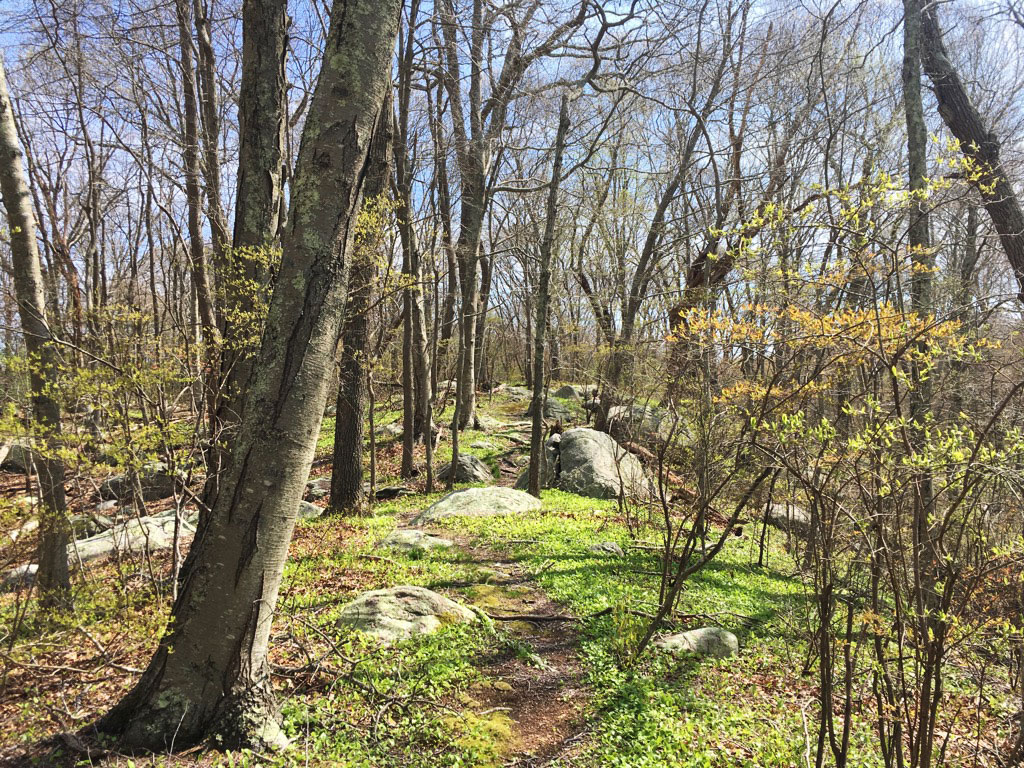Conservation Science
Protecting Fishers Island’s Forests
As steward of the Museum’s Land Trust, Jack Schneider is constantly monitoring the health of the Island’s natural habitats. In 2021, Jack noticed signs of Beech Leaf Disease (BLD) in the American beech stand along Island Pond Trail; he reported it to both the New York State Department of Environmental Conservation (NYS DEC) and the Connecticut Agricultural Experiment Station. This action prompted the NYS DEC staff to undertake a study to assess the forest habitat in the Land Trust and make management recommendations to maximize forest health. The researchers came in April 2022 and surveyed the forests in Brick Yards North, Brick Yards South, Chocomount, and Betty Matthiessen preserves.
As Fishers Island is located within the Atlantic coastal pine barren region, it may originally have had more pine trees than it does today. Yet with a history of agriculture, human disturbance, lack of fire, and weather events such as major hurricanes, pine regeneration has been suppressed, while the growth of hardwoods has been (unintentionally) encouraged. Today, Fishers Island contains primarily closed-canopy hardwood forest. The researchers noted that the sites they visited were dominated by black oak and red maple interspersed with black cherry, yellow birch, and Norway spruce. However, they observed some pitch pine and white pine regeneration in the understory.
The American beech forest is found along Island Pond Trail, where the trees have grown up in open, sunny conditions. While the researchers noted the symptoms of BLD in the Museum’s beech stands, they were not able to determine the severity of the infestation without more intensive monitoring. The severity varies between groves. One grove is nearly totally defoliated while others are just starting to lose leaves.
The Museum is undertaking an experimental program to try to ameliorate the disease progression.
The NYS DEC survey resulted in three recommendations for the Museum’s Land Trust:
1. Implement forest management practices that will protect species diversity and promote regeneration of natural communities to make trees more resilient to forest health threats and climate change.
By protecting and managing areas of less-encountered tree species, we can protect the overall biodiversity on the island. Protecting the biodiversity of tree species will guard against forest devastation by diseases like oak wilt or the Asian longhorned beetle; neither disease has yet reached Fishers Island, and a diverse forest would minimize spread if an outbreak should occur. Opening the canopy will allow shade-intolerant species such as black cherry and yellow and black birch to regenerate and diversify the forest.
To protect and promote the pitch pine and the American beech, the researchers recommend prescribed fire. They felt that widely-spaced pitch pine is less likely to be attacked by southern pine beetles, and fire prepares the soil for seed germination. Further, prescribed fire helps to prevent wildfires, which could devastate rare ecosystems such as our maritime beech communities. However, the foresters’ recommendation for thinning is a generalization based on localities where pitch pines are dense. Since there are no dense stands on Fishers, thinning of the oak and maple overstory coupled with prescribed fire and/or removal of leaf and tree litter would be a possible route to encourage pitch pine regeneration.
Researchers observed a number of invasive species in the forest – such as honeysuckle, buckthorn, and briars – particularly along roads. Because these plants promote tick populations and present a significant threat to maintaining desirable tree species, the scientists recommended that the Land Trust prioritize a plan for invasive species reduction.
2. Work with state, county, and federal partners to treat and monitor the BLD-infested American beech. Build partnerships to increase forest health management capacity.
The American beech are currently under threat from BLD, an infection that can kill a mature tree in under 10 years. While there is no established treatment for the disease, experimental treatments are available and recommended to protect the beech on Fishers Island. Because the experimental treatments require multiple management projects, the researchers suggested partnering with organizations working on this issue. Possible partners include NYS DEC, Forest Health Diagnostic Lab, Connecticut Agriculture Experimentation Station, and Suffolk County Cornell Cooperative Extension.
3. Prevent the introduction of new, harmful invasive species by bolstering interception efforts at island entry points.
As it is generally easier and more cost-effective to prevent invasive species’ introduction than to control infestations, the researchers recommend that we increase invasive species prevention efforts, especially at the ferry terminal. Equipment coming from the mainland could transport invasive plant parts or soil containing invasive species; the invasive worm species currently making headlines are transported in soil, whether it be on equipment or in materials used for landscaping. Managing the worm populations within infested regions has so far proved impossible and the damage to the soil is irreversible. Egg masses for non-natives such as spongy moth and spotted lanternfly
are also often transported on outdoor equipment. The DEC Forest Health Diagnostic Lab could help us implement screening protocols for high impact forest pests to prevent the most noxious invasives from overtaking Fishers Island’s forests.


